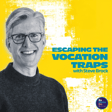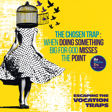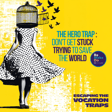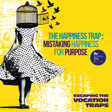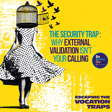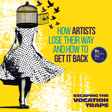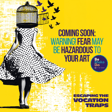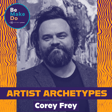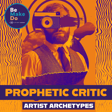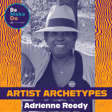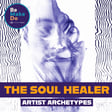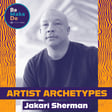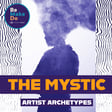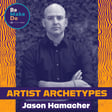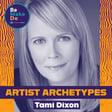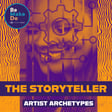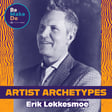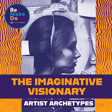Creating the Wise Hearted One Study Guide
00:00:00
Speaker
Hey Lisa. Hey Dan. This Wise Heart at One series is awesome. It is. Having such a good time with it. I want to spend a little bit more time with it. Maybe we should create something.
00:00:12
Speaker
That's a great idea. Maybe something like a study guide. A study guide? Yes. That sounds awesome. Where would I get that at? Well, actually, if you go over to soulmakers dot.org backslash BMakeDo, you can download a free Wise Hearted One study guide right now. It's got lots of great questions, some word studies, and a little bit of commentary for you and maybe a group of people to go through together.
00:00:37
Speaker
That's awesome. That's what I'm going to do right now. What are you going to do? I'm going to go to soul makers dot org backslash be make do and download your free study guide.
Bezalel's Story: Art and Culture
00:00:58
Speaker
ah Hello, welcome to Be Make Do, a Soul Makers podcast where we talk about what it takes to pursue your calling with spiritual wholeness and creative freedom. I'm your host, Lisa Smith, here with my producer, Danny BH. Hello, everyone. And we have been, as you know, exploring the story of Bezalel and the wise-hearted artist call in Exodus on the podcast and examining the deep impact that art, creativity and imagination have on culture shaping.
00:01:27
Speaker
So in light of all that, we've been unearthing the role that artists can and do play as, I would say contemplative leaders, and trying to look at tools and frameworks that can help us navigate our call from this perspective.
Joey Thomasoni: Art and Faith Journey
00:01:42
Speaker
So I'm so happy today to welcome into the conversation artist and pastor, Joey Thomasoni. Hey, Joey, thanks for joining us. Hey, great to be with you all.
00:01:53
Speaker
Joey is ah a husband, a father, a painter, and a pastor residing in Annapolis, Maryland. His work includes national and international collaborative projects exploring the intersection between faith, beauty, and life. His work has been shown internationally and published in the Washington Post, USA Today, and other online and local media outlets. Joey shows his work in galleries and alternative spaces around the US and consults with organizations and churches to cultivate beauty within their ecosystems. I love that.
00:02:24
Speaker
Joey holds a master Master of Fine Arts from American University and an MTH from the University of Oxford with a focus on theological beauty. So he is very qualified to be having this conversation with us. um And I didn't mention that you actually did a residency with Convergence, our local faith community here in Alexandria many, many years ago, and taught me so much at the time, especially kind of setting some of the foundational principles to really be focused on.
Artists as Leaders and Influencers
00:02:53
Speaker
and asking questions and creating community for artists. So talk about artists as a leader. Here you are. I've been really just looking forward to sitting down with you and chatting. um Likewise. Yeah. So I want to talk today with you about your thoughts on artists as leaders, your experience as an artist in various forms of leadership and what what do we even, you know, maybe how we might even think about that um and why art matters and why Christians making art matters and all of the
00:03:30
Speaker
all of the things, right? Yeah, all the things, yeah. All the things. So why don't we just start by just having you share a little bit about your background and what you're into now and how you ended up where you are. And yeah. Yeah, sure. Sure. Well, again, just great to be with you all. And I'm so thankful for this podcast and the work you're doing. I think it's It's significant work for artists who are thinking about their craft and thinking about how their craft relates to their faith.
Early Artistic and Faith Experiences
00:04:05
Speaker
Even maybe artists who are listening in who don't yet have faith or exploring faith, I think this is a really
00:04:13
Speaker
beautiful vision you have to help people to make that and have that intersection. um My story is um i I just began making art when I was a little boy, like like most of us do. um but Many of us, you know unfortunately, stop making around six, seven, eight years old. and It seems like we make less things intentionally as we grow.
00:04:38
Speaker
even though we're all continually making things we may not see it in that same playful way but i just kept making drawings and paintings and sculptures and it's just part of my story and my parents were very gracious to encourage that to foster that.
00:04:54
Speaker
and so And I was raised in in a church context. And I'm so thankful that some churches have toxic environments where the arts are sort of marginalized. And why would you waste time making a drawing? Why would you waste time? But you know in the church I grew up in, which actually had quite theological conservative roots, were very open to the idea. So in seventh grade, I remember
Church Planting and Artistic Creation
00:05:18
Speaker
being approached by somebody on the leadership of the church. They said, we have this Children's room and we would love to know is our mural and would you we know you like to draw and would you paint on the walls and so i have all these experiences early on around that six seven eight three time where i had i was given the profound gift of painting on walls murals.
00:05:41
Speaker
and They were all wretched murals. i mean they were just like they they were They were not aesthetically pleasing, but the practice and the opportunity and the gift of um making was really valuable. and My parents nurtured that in me and the church nurtured that in me. and so When I met met Jesus in a personal in a personal way, in a real way, um you know, we might say ushered into the new life, into the new creation around age 14. The making of art was just a natural thing I was already doing and it just continued. It's so great.
00:06:19
Speaker
I also felt in that time a sense of calling into ministry, but it was like, well, what would that actually look like? Because I know I'm not necessarily going to be the kind of person who kind of pastor or minister who sort of stands, you know, behind a pulpit in formality, you know, and there's nothing wrong with that at all, but I just knew it was more of an entrepreneur, more of a creative, more of an artist.
00:06:48
Speaker
Yeah. that would That would cause a lot of problems for me and for probably anybody I would be speaking to. so Long story short, um we stumbled across this thing called church planting, which in its essence is a kind of making where you're working not just with paint, but with people. And of course, it's the Lord who's doing this and making connections and creating new things. And so, um you know, foundational to the function, I think, of church planting or new church formation or experimental church formation is
00:07:25
Speaker
The same thing that an artist does when they go into their studio So I was really
Balancing Roles: Painter and Pastor
00:07:31
Speaker
thankful. but And I, of course, had a ah wonderful mentor for many years in Mako Fujimura, who was at the time planting a village church out of Redeemer Press in New York City. And so sort of saw a model of, OK, you can be a painter and a pastor. You can make art. And you can also have this unique calling and ministry. And not every artist has that. Mine's I'm a little bit of a unique. ah We're all unique, but i'm I'm a little bit different in that way.
00:08:01
Speaker
But I guess I've just been so grateful to have people in my life who have affirmed that. And so the really the really amazing thing that happened when, and at least you know this about my story, I think, is we had helped start a church in our area here in the Annapolis area.
00:08:17
Speaker
And there was a question that sort of emerged, should I, you know, the the pastors of the church were very encouraged and, you know, you should come on staff with the church, or maybe we really see this sort of vocational ministry calling on your life. You should maybe go to seminary.
00:08:34
Speaker
And then there was like this third option out there um um that that Katie, my wife and I, we had just been married, sort of have this hunch of, well, maybe there's this maybe there's this other option of going to graduate school for painting an MFA, which is like, wait, what? on staff of a church or go to pursue your MFA. And as we prayed, we really did have a strong sense from the Holy Spirit and from friends and from, you know, wise council leaders in our lives say, you really, you really should go to pursue the MFA. And part of that was, you know, we're thinking about
00:09:11
Speaker
The trauma, the damage, the hardship that has gone on in our in our culture from from many different from many different places, but specifically the hypocrisies of the church and people you know up to 80% of our population are you know what we might say have become religiously disenchanted. They're not they're not waking up on ah on a Sunday morning saying, wow, what what church should we go to?
Choosing Seminary or Art School
00:09:38
Speaker
they're They're actually thinking, I want to stay as far away from that place as I possibly can.
00:09:43
Speaker
And so we felt like spending time with artists who didn't have any faith background was a really wonderful way to sort of learn um the language of the culture in order to translate the hope of Jesus, the the good news into this this sort of volatile, we now use the word of an estuary estuarra world that we live in,
00:10:10
Speaker
And I can't tell you how much I learned from my professors and classmates at American University in DC is where i where I did my MFA, who didn't have any faith background and probably at times were quite confused by how could I be an artist in this program who has faith and I almost got kicked out of the program, which is another interesting story to tell, um maybe for another time. it was It was just such a gift to be there and um learn. And it really, and the Lord used it as a ah rich foundation for the work that we've sort of been doing now over the last 20 years or so since then. yeah And i do I do feel like my calling is as an artist and as a minister, as a pastor, as a missionary. um i sort of
00:10:59
Speaker
live somewhere in between those those worlds. and um But it's all integrated for me. It's one thing that the Lord's called me to. So I still make paintings. and make these I have a few right here. I just i sort of take these i do these little plein air paintings. I take my my little plein air box into the city or into the neighborhood or the soccer practice or whatever it is. and just pray and find a ah point of where I sense the Lord wants me to pay attention and then just respond visually. And I give myself about an an hour, and it's like painting painting the hours, and um you know it's ah it's a spiritual practice. And I'm so thankful because, you know again, you make a lot of wretched little paintings, but a few gems come out here and there. And the Lord tends to use these paintings to meet people
00:11:52
Speaker
As they see them, they resonate with a color or shape. I'm trying to sort of walk that line between objectivity and you know that sort of more ethereal abstraction, of the cosmos, that you know the mystery and the wonder you know yeah of of who God is. So so i'm I'm still painting. And then I also serve as a pastor at a church here at Annapolis called Downtown Hope that we started in 2009.
00:12:21
Speaker
And more recently we started a non-profit called Estuary, which is really sort of i think it sort of bridges the gap between maybe the church and the art in some ways, and it's um where we're really sort of walking alongside of people who want to have a kind of creative impact.
00:12:42
Speaker
in Jesus' name, ah in the in their cultural estuary as we talk about it, where they live, where they work, where they play.
Estuary: Bridging Church and Art
00:12:49
Speaker
And so people get these fantastic visions and and sense of impressions of what they want to do. And then we have the gift of walking alongside of them and helping them dream about it and think about.
00:13:02
Speaker
What is that next step to take? and so it's sort of like In a way, we're sort of equipping artists who don't know that they're artists in the making of in the making into and part of you know the new creation, which is upon us, yeah which is which one day will be here in full. I'll pause there and say that's that's a little bit of what I've been up to and what I'm doing now. so Yeah, I think it's amazing, Joey, I really I really do. And it's so interesting to see how all of this is sort of moved and and played out in your life. And I think um you and I have some similarities in that, you know, starting out from that artistic background, and then being drawn into
00:13:42
Speaker
yeah the pioneering world of church planting and what is why am i even here but it does feel right and it makes you know i can't i'm not going to be the traditional thing but but i i just i look at you and i uh listening to your story and what you're doing with estuary i think you know, so often, um ah church leaders, I have these conversations with church leaders and or artists, because the church leaders are afraid of what would artists do if they're given the freedom, you know, we got to be careful. And yet here you are, like, this is an example of this is what it looks like when an artist leads when an artist kind of envisions. Oh, all of these amazing, you know, ah because just like you're talking about your plein air painting, about that being an a ah a spiritual discipline, at this practice of prayer. It's like, artistic practices, i obviously, I think teaching and leading within congregations or other people to to be able to
00:14:42
Speaker
enter into prayer through these you know more sensory means is one thing. But then you expand that out to what you're doing with with estuary. What you're doing is helping people to use creative senses and abilities and tools to um really unearth the giftings and the callings that God has placed on them that maybe don't fit into the typical boxes. So it's it's that artist's mind. It is that that MFA training that actually allows you to be able to do ministry in a way that I think is so life-giving for this moment. I really do feel like it is a movement. It is God calling forth artists to lead in these unconventional ways because that's exactly what
00:15:33
Speaker
You know, it's this breath of fresh air within churches. So I think it's just really, really beautiful. I mean, what are what are your thoughts about about that, about so this expanded role of artists, specifically maybe within church leadership or the the life of the church beyond just music minister or something like that? you know Right. right right right right yeah yeah and I think it's all important. so you know The music minister plays a ah critical ah critical role in the art on the walls and in worship context. Sacred, sacred art is incredibly important. and There's obviously a rich history in the church as a whole, particularly in the Catholic and Orthodox traditions.
00:16:17
Speaker
I think the Protestant tradition is sort of learning, reclaiming, and there's been, as you know, good a real movement over the last 20, 30, 40 years, and in at least in the US, I'm sure it's broader as well, with Christians in the visual
Beauty Against Cultural Reductionism
00:16:32
Speaker
arts and international arts movements and, you know, our house and these kinds of these kinds of the great leaders in our area, in our culture, in the church who are really helping that.
00:16:45
Speaker
But there is there is another sort of, I agree, there's another sort of step beyond that um that encourages um people to begin thinking about the ordinary places they find themselves, where they live, work, and play as spaces, as as blank canvases in a way that the Lord wants to inhabit and wants to bring forth um Oftentimes, it's sometimes it's creative solutions to problems. um Sometimes it's just beauty for the sake of beauty in ah in a place.
00:17:22
Speaker
um the whole Our whole Western, you know, American culture has been sort of in a way devastated by the Enlightenment and everything is there's so much reduction ah to functionality, and this sort of is across whatever your faith background is. And so um the church and the Christian faith holds this really special you know, resource called beauty and an application for the arts that allow I think what I hear you saying, and I agree with it is sort of unlocks and sort of breaks up some of that reductionism and sort of, um you know, adds color to sort of, um you know, a very sterile
00:18:10
Speaker
cultural moment that we're in and you know and and many have been riding on this sort of this notion of re-enchantment and people are you know so interested someone was talking to me yesterday about a homeless shelter in our area is having a fall fest and at the fall fest there's gonna be tarot card readings and there's gonna be all of these things and it's like wow that is a really interesting world that we live in now that this homeless shelter doesn't have any faith background or is it isn't not associated with any particular church but somehow for their fall festival there's people who are interested in the the spiritual realm as it were and there is that hunger i think that people come to where they're like wow um a white cube is maybe not necessarily there there must be more to life than a white cube in a way
00:19:04
Speaker
and And that was actually part of why I started painting outdoors, is I was primarily working in a white cube studio. Again, there's nothing wrong with working in a white cube studio. Many artists are called to that, but I just had this deep conviction of I need to kind of get out into the messiness of the world and into the streets where there's sidewalks are have cracks and people are annoying and you know but you're stuck at red lights and all these things where, you know,
00:19:33
Speaker
let's let's Let's explore and discover the beauty that is is happening in this in this canopy, in this in this grand um canopy of the world that God has made and is certainly affected and marred and distorted in, you know, Augustinian language by by sin, but that there's a bigger story of God putting things back together and restoring and ushering in his new creation and so let's go participate in that you know yeah in a way let's get out of the
Engaging with Complexity and Beauty
00:20:04
Speaker
white cube and in a way let's get out of the sanctuary right right move let's move from it let's move from the sanctuary into the estuary which is which is a dangerous space and this
00:20:15
Speaker
you know An estuary, of course, is where salt and freshwater collide, and Mako is the one who introduced this great metaphor to me. we We live here on the Chesapeake Bay, which is one of our nation's largest estuaries. and so We're sort of trying to live into the live into the metaphor here, um but it's dangerous. It's volatile. It's not safe.
00:20:36
Speaker
Yeah. But actually, almost everything Jesus is doing through the Gospels is not is not safe. Right. It's good, it's good, but it's not safe. Yeah. I really do, like we were talking about, we've been exploring the the story of the making of the tabernacle in Exodus. And this design that God has, which is that is to be a witness to the nations, to be very visible. And I was just it struck when I read it for the first time in reading through all the detail of the the story, just how intentional God was with the aesthetics of it and
00:21:18
Speaker
just really blown away by the reality that, okay, God created us to appreciate these things and be affected by them in this way. he He's using them to do something in us and on us. Wow, this is much bigger than, you know, I thought this is huge. And and this idea of of moving out into those spaces to be tower you know to be these witnesses, to to yeah shock and delight and inspire awe and question and embrace and all of these things that art just naturally does because that's what it is, that's what it was designed for. Yes, yes. And how do we as artists start taking these things
00:22:03
Speaker
more seriously, I think the theological implications of what God designed it for. This feels to me like a newer conversation um in a lot of ways, which then leads up to this leadership kind of conversation. I think that, you know, a leader, I mean, there's many ways to define what a leader is, and you sort of have lots of that language, and and again, and sort of contemporary business, you know functional, you know a leader does thing, the leader gets things accomplished. But I think maybe more fundamentally, and and leaders do those kinds of things, but I think maybe one of the fundamental things the leader does is influence or shape. right I think that a leader is somebody who comes into a space and can, with people, whatever they are doing or wherever they are going, they're sort of
00:23:02
Speaker
the space moves or the people move with them to some degree. And that's a real, that's that is an incredibly, it's a gift and it's a humbling, it's a very humbling thing. it's a very It's a very special thing and it's a thing that we, those of us who have been given that gift, it is a gift from the Holy Spirit, a gift that God make some people gets just gives people at birth and their personality and all their unique makings.
00:23:31
Speaker
But it is ah it is a really important stewardship that, as we also have seen, can easily be abused. And there's certainly been times in my own life where I haven't been. the kind of leader that is shaping things for good in people's lives. So I just would say I think it's about influence the and and the shaping of or the the the moving of people in a direction. And and and that is exactly what art does. is it is it it Art is and when we make something
00:24:03
Speaker
we're introducing we're We're either bringing different things together in a new way or you know i mean ah or we're sort of bringing something new into an existing environment. and that that will be to some degree a catalyst for change right well that's the thing about art too is that you don't have well maybe it's an illusion that anybody has control over the outcome of of their their leadership but with art in particular there is a sense that you feel like you know i create something even if it's a space or an experience
00:24:39
Speaker
I can't necessarily and even as an artist a lot of time artists are very reluctant to to want to affect a particular response you know they want to create something in. But um but i think that there's so much i think this again is why like you were you were talking about.
00:24:58
Speaker
sort of the heaviness of that reality, the humility, that that there really does need to be a sense of submitting ourselves to discipleship and training to really understand this as a gift and a responsibility um that really there is this nature kind of nature of being a conduit for God to work within these things that we create. um Yeah.
00:25:24
Speaker
And I think that can be kind of heavy for artists. I do kind of notice when I have this conversation with, there's a reluctance to like, don't don't put all that on me as an artist, you know, I'm a, yeah I just, I paint and my faith is over here, but I,
00:25:41
Speaker
And i and i think that's fair I think that's fair to just say i I do it as an expression, it's just what I do. But i I do wonder if there's a way to think about it, which allows the freedom, actually maybe allows for more creative freedom to go into all kinds of places, even the dark places.
Artists as Cultural Missionaries
00:26:01
Speaker
um As an explorer, ah you know as a as a a way of, um I don't know, bringing to bringing to life, bringing to life, like you said, introducing new things to into different spaces.
00:26:15
Speaker
um and is it's like it's like a but mis you know It's like being a missionary. or a you know
00:26:24
Speaker
How can we, how can we think, I mean, I'm putting you on the spot, but like, how can we think about our role as creatives from a, you know, um an integrity as an artist. So we're not talking about propaganda or just like trying to get across some message, but at the same time, maybe hold that original kind of, you know, cultural mandate, you know, if we're supposed to create cultures, create the world, and that's what we're trained to do. I mean, shouldn't we take that seriously, I think, and not be betraying anything artistically that I feel like that's, I'm throwing stuff at you. with you Yeah. No, it's great. These are great these are great questions. i mean I'm sort of thinking through this in in real time here with you, and I've spent a little time thinking about this as well. I think um one thing that I think is important for artists is that so there's this there is this rampant individualism in our in our Western context, and I think it's very easy, understandably. Many artists
00:27:32
Speaker
are more introspective and more introverted and more internal processors, which is going to be a natural drawl to be alone. yeah and And there's nothing wrong with that. But I think it's all it's also really important. And I think the Christian faith sort of offers this in a really profound way that at the center of the Christian faith is a God who is community, Father, Son, Holy Spirit. And so an artist should be encouraged to know that they're not alone.
00:28:02
Speaker
And so some artists may have may have more of a natural propensity or a gift or a desire to sort of get their stuff out there and to be more proactive. And you you taught you share vision with them, Lisa, and they're like, yes, I'll go do an installation on the street because I want to like create beauty there. and you know And others are going, hey, don't put that on me. I just want to be in my studio.
00:28:25
Speaker
I think both are okay. I mean, the encouragement is in both cases. I think you actually see this in the in the Exodus narrative is that, um you know, Benzelil has a partner. He has ah is a friend who's there with him creating. And he also has he also has a broader community in Moses and Aaron.
00:28:43
Speaker
And so we need to think about this in in terms of an ecosystem and a dynamic community of a variety, a range of gifts. Like, you know, the New Testament has so much to say about this. This person has this gift and this person has this gift. And when it all comes together, it actually functions in itself as kind of a living composition, doesn't it?
00:29:03
Speaker
So I think artists can be encouraged in that and it's also a ah real exhortation to people who are maybe in you know formal but you know leadership positions in the church, pastors in churches, whoever the leaders are in that setting is to see artists to pay attention to them and to welcome them into the conversations and not to just It's both not to let the artist be in there ah in their world, isolate it all by themselves and just sort of maybe enable that, to draw them out, but it's also to say what, to see the artist and say what you have to offer the body of Christ and the world and and the community around us is really valuable. So yeah we need you not only to make art, keep making, please, we'll help it will help fund that, we'll help encourage that. And we also need you at this meeting,
00:29:54
Speaker
we we We also need you to help us think about the children's ministry, or we we also really need your eye and ear on the flow of our gatherings on Sunday mornings, and and not because we need you to make it pretty, not because we need you to ah you know dress it up.
00:30:12
Speaker
You have a mind and you have a gift. As an artist, you're going to see things we don't see. And we want to make sure we're thinking about and stewarding all that God has entrusted to us in this local community we call church. And your voice and your gift and your person, who you are as a person is valuable and we want you here.
00:30:34
Speaker
And so I think that then there's a little volume, it sort of it both challenges the artist to say, but you you don't you don't get to just stay in your studio by yourself. No, no. yeah Think about what people are missing out on without you being here. And we so appreciate what you're doing in your studio and we want you out with us as well.
00:30:53
Speaker
I'll say one other thing is one of the things that i think is indicative of sort of again a modern reductionistic vision of the world and beauty of course was you know it was a ah victim of that in some ways is that.
00:31:08
Speaker
We sort of reduced the craft of making as an artist and we reduced our vision of beauty into this very like, it can't be functional at all. We can't have anything, and can't have any if it has if it has any purpose, it's not real art. If it has any purpose, it's not real beauty. yeah And i think i think that's actually problematic um now of course we have seen the extreme on the other end where it's propaganda and we're just making in order to get you know some means to an end and that's also equally unhelpful but i think.
00:31:45
Speaker
The vision of beauty in the new in in the scripture is actually this really wonderfully integrated you know vision of when you get beauty, you also get truth and goodness. And when you get goodness, you get truth and beauty. And when you get truth, you get goodness and beauty. And so there's sort of the early church fathers talked about like the convertibility of these transcendentals. And therefore, you might make something, and it might do something really good in the world.
00:32:11
Speaker
And that's okay. ok It's okay. it yeah You might make something and it may not be so ethereal and mysterious that nobody understands it. Somebody might come in and look at one of your paintings and they might say, that is beautiful and I totally get it. It's so clear to me. That's okay. You didn't fail.
00:32:34
Speaker
You didn't fail. It's okay. yeah So I think we need some some grace in this conversation as well. And then some work of art is meant to be like, it's meant to be completely evocative. You walk away and you're like more confused or upset even. Let me share this. This is so great. um I was with my sons this last week and we were walking through Mark chapter three where Jesus heals the man with the, you know, his hand was um you know, injured his hand his hand. I can't remember the exact language. And he it's on the Sabbath, and he and Jesus goes into the synagogue, and he's there, and he asks he he poses a question. I mean, this is ah this is a living work of art. I mean, this is a performance piece that Jesus is on is unfurling here. right
00:33:25
Speaker
and he And the stage is set and the and the religious leaders are there and he says, you know, is it is it right to take life or, you know, to to to have life or to kill on the Sabbath? And they and they're silent, you know, which just the tension rises in the room. And it just is Jesus looked at them angry.
00:33:48
Speaker
their hardness apart. And then he does this miraculous healing and he walks out. He drops the mic and he walks out. And and their response to this work of art is not how mysterious, how beautiful, how how evocative. Jesus just flipped the law on its head and helped us. Some people there may have thought that way. The Pharisees didn't. They said, how can we kill him? yeah until they went out and and plotted on how to destroy Jesus. And so there is also art that...
00:34:20
Speaker
is absolutely evocative. yeah And it's ah it's important that artists are faithful to that as well if that's what they're called to do. Yeah, absolutely. Well, kind of moving away from the church world in particular and looking at the broader cultural context, um I think I mentioned in an email that Deborah Haynes' book, The Vocation of the Artist, was really just a catalyst for a lot of questions.
00:34:46
Speaker
um that I've been exploring over the last 20 years, I guess. um and that's right yeah she um She talks about how artists have served different roles over the centuries, you know, that torture genius and pseudo religious conduit and, you know, all these different kinds of things. And I know, you know, you mentioned Mako Fujimura, he kind of talks talks about that too, that in the 20th century, artists were, you know, really drawn our attention to what's wrong in the world basically, but you know what what is this role for the 21st century? And she talks about um basically working from a perspective that art making matters and that it serves to impact the culture in significant ways. and
00:35:29
Speaker
you know given the challenges facing our world in the 21st century that you know perhaps artists should consider taking seriously the possibility that what we do can serve as this prophetic criticism and imaginative visionaries and help lead the way in addressing some of those concerns or or basically help help us to tell the truth about ourselves and envision multiple possible alternative narratives to the kind of hopeless ones that sort of surround us. And I mean, even though I don't think she's a Christian, I don't think she would call herself a Christian. I feel like from a Christian perspective, that makes a lot of sense. What what are your thoughts about the role of the artist within culture, within the industries go, I mean, a lot of what I do is in encourage, you know, it's,
00:36:20
Speaker
I meet a lot of people at that intersection that that you and I kind of wrestled with, and some people, it makes sense. Yeah, go go to seminary. Other people, it's like, no, go get the MFA. Go to Hollywood and be a filmmaker. That is where your calling is um not to make, quote unquote, Christian music movies or music, but to make art.
00:36:44
Speaker
period. yeah um what are What are your thoughts about that, the role of the artist in the 21st century and all that other kind of good stuff? Yeah, even though she may not identify as ah as a Christian, she's being, and from my perspective, being an image bearer, being created yeah as an image bearer. She's sort of participating in or tapping into, you know, one of the foundational things that God does in the world and then He encourages us to do, which is to make. So I think that's really i think that's really good what she's thinking about. I think, you know, that that kind of thing can become, um you know, most fully known um in in the person of Jesus. But but we're we're here we're here in the world as artists of faith or just as artists,
00:37:34
Speaker
and And then we're in the 21st century here, which there's obviously many things unfolding. um But I think we're sort of reeling a little bit from much of the deconstruction and the sort of trauma of the 20th century.
Art's Role in Unity and Transcendence
00:37:50
Speaker
And I think what I'm seeing that is clear is there's, again, it's a a small picture, a small sliver, we we see dimly. So there's many things going on in the world. But at least in a Western context, there seems to be this idea that our current
00:38:12
Speaker
Maybe we might say post-Christian or secular vision of the world is not fully able to deliver on the the hardships that we're facing in terms of meeting those needs. um And particularly, I'm thinking around this the the the notion of division and divisiveness.
00:38:34
Speaker
And this is really sad as we see it play out in culture from politics to you know education to academia, whatever it is. There's just a lot of division happening, ideologies. And so I think part of the role of the artist is I would actually advocate for the creating of art that has in its eye or or out beyond around shaking beauty. I think beauty is the, and this is what some of my focus has been, you know, at the University of Oxford, is beauty ah is a resource. It's not a resource to be quote unquote used per se, but it is a real thing that God is a very, part of his very nature that is at play in in the world.
00:39:31
Speaker
and Beauty, one of the things I'm thinking about and writing about is but one of the most important characteristics of beauty or how when we experience beauty, one of the things we're experiencing is unity. but When a composition is unified, it radiates a kind of beauty. and so beauty then moving the in the other direction as we cultivate beauty, as we experience beauty, as we have and a lot of it is as we have eyes to see and are able to theologically, or maybe if we're not even a person of faith just to acknowledge and see beauty, um it actually is a kind of balm, a kind of grace, a kind of means of grace that in a profound way treats divisiveness because
00:40:21
Speaker
when we experience beauty, you know, maybe we say lower lowercase B beauty in anything, what it actually does is it lifts us to see, if if it it points us to the transcendent to see a a kind of, whether we believe in God or not, we're lifted out of our moment and we see that there's things that are bigger than we are. There's things that are but transcend this situation. There's bigger things going on in the world. and It sort of grabs our attention. It sort of arrests us in that way. and we're lifted We're lifted out of the divisiveness. and We're lifted out of the trauma. and and then and Then we're no longer looking at that person next to us as the enemy.
00:41:13
Speaker
because we're realizing, oh my goodness, this is such a small thing that I care about here. In a way, it's maybe a little way of, you know, there's something that has to do with worship there in that we're sort of lifted out of our are our ah idols in that moment, all the insecurities and fears and everything, and we're sort of, you know, transported into the presence you know you go talk about the tabernacle yeah into the presence of ah a God who is bigger than these things. yeah so ah So I would advocate for the cultivation of beauty and artists thinking about their work and how their work actually has the opportunity to radiate beauty. and
00:41:59
Speaker
what do you mean by that well what i don't mean is like pretty flowers and and you know and and all the things puppy dogs and and you know like some sort of cliche imagery like i'm talking about a ah beauty that is robust that pays attention is honest and transparent about the trauma and the hardship that that that says there is darkness but but.
00:42:25
Speaker
there's another story that's being written. yeah So, yeah, so I guess those are some of my initial thoughts on that. Well, I was gonna say one one last thing related to this. I've been thinking a lot about Jesus' prayer in John 17, Jesus' high priestly prayer, and he prays that but he prays for those who would believe. And then the prayer is that he prays that they would be won or that they would be unified.
00:42:53
Speaker
even and then he connects it Even as you know the Son is one with the Father, so we're sort of then connecting this to divine participation divine participation, mirroring the Godhead. And then the outcome of that is, so that the world might believe.
00:43:10
Speaker
So there's there's something in Jesus' prayer that to the degree that there's a unity happening, and of course his prayer is in the context specifically of the people of Jesus, the body of Christ, is the degree that there's a unity there, there's a beauty that radiates, and that beauty is actually deeply attractive to the watching world. The watching world sort of sees the kind of unity and it's rate and and the beauty that is radiating out of it, and we're like, wow.
00:43:38
Speaker
That's the kind of community that I long that I'm longing. I'm so alone in this individualistic world. I'm so tired of all the division and all the drama and all of the just everything. Is there any balm? Is there any stop? It's like, ah.
00:44:03
Speaker
Here is a community that is so loving and so unified and so interconnected. Yeah. That's beautiful. Yeah. The opportunity of this time that's so different than you know when I was in high school, probably when you were in high school. you know ah in this The context has shifted from that that modern perspective, which is prove it to me. you know Let's intellectually understand this.
00:44:30
Speaker
or even the need to tell you why it's important to consider these Jesus things to this moment where it is just as simple as, please tell me there's something more, like, please tell me there's something more than this. And so that opportunity that that just to simply be able to invite people into this experience of of beauty, of of that unity, of of that reality, of wholeness in Christ. like it's It's that simple and it's that complex because it has to be real. it has to and that And that's, I think, part of
00:45:09
Speaker
yeah I think part of what this this this movement, this calling artist forth maybe is about of the Holy Spirit is that this isn't a time for for logical words. We've done that. you know This is a time yeah people want to open their hearts and you know touch something deeper.
00:45:33
Speaker
Incarnation, I think part of what you're getting at is is the the notion of incarnation. There's something that has to be physical, tangible yeah around the experience that the Lord uses them. Eventually down the line, people might, you know, they will be intellectually convinced of something, but initially,
00:45:52
Speaker
And I agree. I think the world is fatigued from the church, sadly, in many ways, and and the and the culture is fatigued from the culture in many ways. And so beauty, art, art making becomes this really powerful experience place where People can start to flow down and catch their breath a little bit and and then that is, that does become a, mean we're not we're not making things for that reason but that's the actual, the effect, the impact of of beauty and art in the in the world and it's sort of really, um people are moved by that and they're compelled by that and they're healed in that and they're drawn to that.
00:46:42
Speaker
i you know I do think if we think about these three transcendentals, um people aren't interested in the conversation around truth right now. I know there are a few people, but the the prevailing culture, to your point, let's have a night at our church where we're going to try to convince you that the Christian faith is true.
00:47:06
Speaker
No one's going to touch that. People have a lot of questions about the moral integrity of the church for a number of reasons. Granted, a lot of those stories are that hit the news are the strong exceptions, but they're still they still paint a picture. they still They still create an image in people's minds, and and and there's no excuse for those things.
00:47:32
Speaker
And so people, I think, are in general fatigued by that and wondering, is the church even a moral institution that I want to be part of? The beauty is something that is, is um you know, there's an open door there, I think. There really is an open door.
00:47:50
Speaker
The purpose is not let's use beauty to try to get people into the church. just right like right but I think the purpose, the the idea is um we as followers of Jesus have been given this gift of making and we want to make and steward whatever we have and in the most extraordinary, elaborate ways possible.
00:48:18
Speaker
And what happens is people are drawn to it, and they have questions. And then we welcome them in around our tables or whatever it is. And really interesting things start to happen from there. Well, I know. I was just thinking back to um earlier, you were talking about um the MFA program. And I just know that somebody's going to ask me, like why didn't you have them tell that story?
Art Experiment with Homeless Collaborator
00:48:40
Speaker
Oh, how I almost got kicked out? Yeah. Yeah. yeah yeah Yeah, absolutely. I'd love to tell the story. It's a great story.
00:48:47
Speaker
um so you know as As anybody who's listening who's been part of an MFA program, most MFA programs stateside are influence primarily through 20th century ah modernism and sort of the contemporary mindset of postmodern ideology. and so so So in our program, it was it was actually it was really amazing. we would we would get together and we would put our art on the walls. And then we would talk about everything from world hunger to whether God exists to the atrocities of the world and natural disasters and everything. So it's just like, this is this is ah the the the great part of an and MFA program. It's like, there is a lot of flexibility and latitude.
00:49:37
Speaker
So I'm thinking this is great because this is a really sort of open environment where I can explore my faith in a way where I wouldn't necessarily be judged because we're open here. everybody's were We're supposed to be at least very open here. This is when the Katzen Center was first built probably in 2005, which is like American University's wonderful, beautiful art gallery and their studios there.
00:50:05
Speaker
So at the time, we as and MFA students were given studios that had ah our we had our own keys, so they weren't shared. And at the time, anybody could access that building 24-7 publicly. So you didn't have to have a key to get into the Katzen Center. Anybody could come in at any time during the day. But you could not get into a particular studio because they had keys, they had locks on them. So I was thinking about it was I guess it was like my the end of my first year and sort of the end of your thesis project and I started really praying and thinking about awesome the homeless po population of our city and I was thinking man you know there's homeless shelters but it would be so great if people just welcomed the homeless into their homes but maybe that's unrealistic but what if there were like these third spaces which were sort of accessible
00:51:03
Speaker
to the homeless, but maybe it wasn't didn't put it wasn't as scary or didn't put people as at much as much risk and and liability. I thought, well, a homeless person could come into the Catherine Center and and sort of you know be there all night long. But they would get kicked out if they hung out in the main gallery area. But if they had a key to my studio, um they could maybe sleep there. And then I thought, this is really amazing. This is really interesting. like Maybe we could actually, maybe we could collaborate on this.
00:51:33
Speaker
a painting And I could work on the painting from 9 a.m. to 7 p.m. And then they could work on the painting from 7 p.m. to 9 a.m. and have ah have a warm place to stay and a bed set up in the studio. And it sort of becomes this like really interesting experiment. often you know How do you maybe think about alternative ways to address homelessness and um you know as ah as a sort of a composition unto itself? so It's sort of like melded both of those things together. We're making a painting, but we're really making ah we're we're really talking about a much bigger kind of painting here, that composition.
00:52:13
Speaker
so um So, worked on this and then during the critique, um you know, had the painting, and but the painting was really just a conversation point to say, let's talk about this thought or this idea or this conceptual work of art that Joey has done here as an artist, thinking about his studio in this way. And one of my classmates um was was very, very upset and was livid.
00:52:40
Speaker
and and i And I understand why he was, but he felt one night as he was working in his studio, there was a homeless man going into the studio next to him because he had the key and he was there. And it it put him in a very vulnerable space where he didn't feel safe. And I do have a total sense of empathy for that. And I probably did not communicate. I certainly didn't communicate well. I'm i'm sort of thinking we're in open territory here. so Right. yeah And i knew this I knew this particular homeless man. I had spent time with him, albeit I didn't know all his history, but I had spent enough time with him to...
00:53:17
Speaker
you know to feel like he wasn't going to put any of but any of my classmates at risk or anything like that. but He had to come upon hard times and um you know he wasn't struggling with any um you know with alcohol or drugs or anything like that that I could tell him. He was just in a season where in the cold winter in DC, it would be really great to have a warm place to to stay.
00:53:45
Speaker
so During the critique, one of my classmates just sort of raised you know it was sort of just raised the concern. and you know I just remember one of my professors ah was basically like, um this is an atrocity. how could you How dare you? How dare you do this?
00:54:05
Speaker
and And I remember another professor saying, this is the most brilliant piece of art we've had all year, which is which is great which speaks to the likecon quality of the MFA. Yeah, of the faculty there that they were like two different perspectives, but it was very scary in the moment I said, and I just sort of like in a way sort of gave my defense of the work and I said, listen,
00:54:30
Speaker
We've been in this we've been in these critiques all year long and we have talked theoretically We've waxed eloquently about all of the problems of the world and i'm just assuming Everybody that like i'm just continuing that conversation in this evocative way Yeah, but it was very and that probably was the thing that was the most interesting about that installation was that it it's sort of an I didn't realize this the the work of this work of art would have this, but it sort of in a way exposed the hypocrisy even within our open MFA program that maybe we're not all as open as we think we might be. Yeah. And it was and I think that's why some of the professors were upset. So so the the the department chair brought me out.
00:55:28
Speaker
but just sort of had this like side conversation, he said, listen, I really appreciate your work. I think it's really strong. But these two faculty members are asking that you be removed from the program because you did this. um So I really need you to not do anything more like this while you're here. I love your work.
00:55:54
Speaker
Yeah, so now as an artist in an MFA program, in a very open program, I'm being given very strong rules put on me because i had because and unintentionally, unknowingly, I had completely disrupted the system.
00:56:11
Speaker
And this happens, doesn't this happen in our own lives all the time? In our churches, everything. So it was that was that was the that's the story. I wasn't kicked out of the program. I graduated, which I was grateful for. And I'm so grateful for my classmates and the profs there and the whole experience. And I certainly didn't mean to cause any harm or to to put anybody at risk.
00:56:37
Speaker
and I learned a lot through as well. I think next time i probably it probably i probably it probably would have been ah a better act of love to communicate it ahead of time, talk to my classmates and my professors about it. and you know but you know I think we we learn and we stand in grace. and I was grateful to have that experience. Yeah, yeah the experience itself is is worth a lot. Wow, that's that's a great story. It's such a great story. It was pretty wild. it was It was very wild. Thank you. Thank you so much, Joey. It's been so great listening to you talk and just hear about all the ways that you think about things. it's I love ah love talking with you, so thank you so much.
00:57:24
Speaker
Well, thanks. Thank you for your questions. I really appreciate it. Great to be with you. Thanks for listening to Be Make Do, a Soulmakers podcast. If you want to go deeper, be sure to visit soulmakers dot.org and download our free Wise Heart at One study guide with questions for personal reflection or discussion with a group, plus word studies and more.

